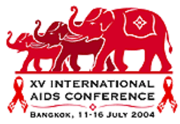 |
 |
 |
| |
High prevalence and late diagnosis of HIV among Black men aged 40-54 in New York City
|
| |
| |
|
|
| |
| |
 |
|
| |
| |
XV international AIDS Conference
11-16 July, 2004
Bangkok, Thailand
E W Wiewel, Y Bennani, C Ramaswamy, J E Sackoff, L V Torian
HIV Epidemiology Program, New York City Department of Health and Mental Hygiene, New York City, United States
Since New York City (NYC) began HIV reporting in June 2000, non-Hispanic Black men have comprised the largest group of people living with HIV or AIDS (PLWHA) and new HIV and AIDS diagnoses. Prevalence among Black men varies by age and geography, as do concurrent HIV/AIDS diagnoses, suggesting barriers to access to testing and care.
The study calculated prevalence of PLWHA as of December 31, 2001, by race/ethnicity, sex, and age, using census data and HIV surveillance data reported through September 30, 2003; and also examined geography, concurrent HIV/AIDS diagnoses, and foreign birth among Black men.
RESULTS
Demographic data were available on 75,362 PLWHA (98.4%).
Prevalence was 1 in 100 citywide, 1 in 43 for Black men of all ages, and 1 in 15 for Black men 40-54 years old, the highest prevalence of all demographic groups (11,039/166,818, 6.6%; versus 2.3% of Black men of all ages).
Of 40-54-year-old Black male PLWHA diagnosed since June 2000 (n=1,523), nearly 1 in 3 had concurrent HIV/AIDS (31.4% of new HIV diagnoses).
While Brooklyn accounted for the greatest number of PLWHA in Black men aged 40-54 in New York City (n=3,258), Manhattan had the highest prevalence, 1 in 8 (2,812/22,776, 12.3%; versus 1 in 21, 4.7% in Brooklyn).
One in 10 of NYC's 40-54-year-old Black male PLWHA was born outside the US: 70.4% in the Caribbean, 21.0% in Africa, and 8.6% in South America.
Non-US-born Black men aged 40-54 who were diagnosed since June 2000 were significantly more likely than those born in the US to have concurrent HIV/AIDS (56.8% versus 30.0%; p<0.001).
The authors concluded that prevalence of HIV/AIDS is high in Black men aged 40-54, particularly in Manhattan, while Brooklyn has the greatest number of PLWHA. The high rate of concurrent diagnoses in 40-54-year-old Black male PLWHA, especially among those born outside the US, indicates that many were long-infected but not tested until symptomatic. Late diagnosis may delay entry to primary care and preventive counseling.
|
| |
|
 |
 |
|
|